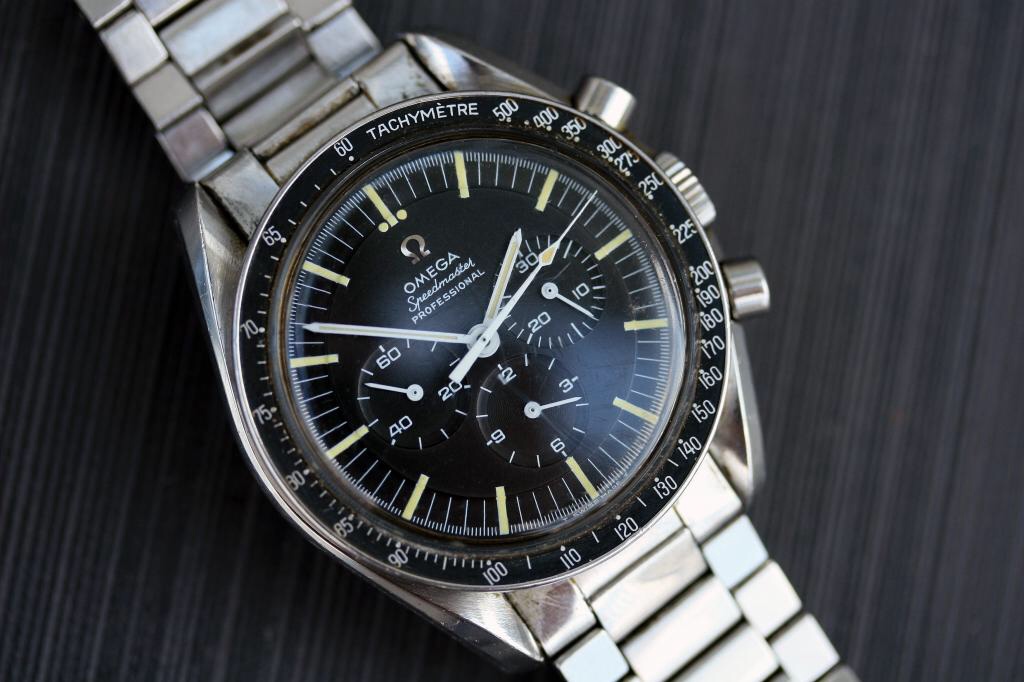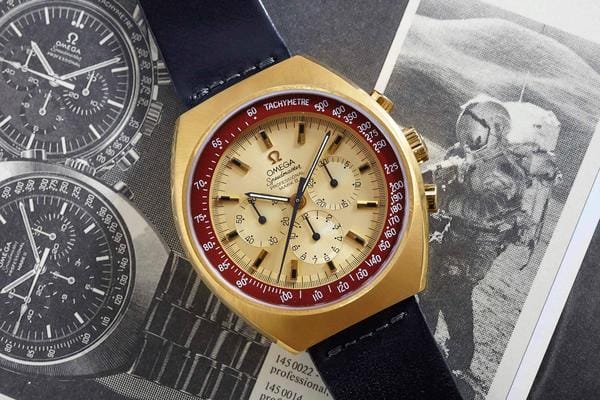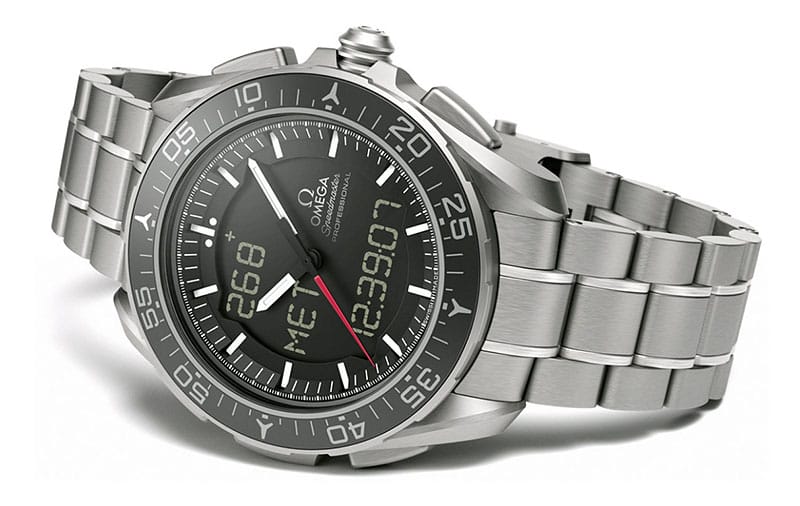
The Omega Speedmaster watch is NASA certified and it has been worn by astronauts both in space and on the Moon. But while that’s fairly common knowledge, what’s no well-known is that there are 60 models of this watch/chronograph – one for every year of the Speedmaster’s existence.
For die-hard fans and collectors, that’s a lot to keep up with, not to mention the expense of collecting all 60!
Fortunately, Omega has recently made it easy to do so by offering 10 models which are most representative of the series.
Of course, the very first Speedmaster, dating from 1957, is one of them. That first watch, surprisingly, was not originally intended to be used in space; it was, in fact, designed to appeal to racing drivers and car enthusiasts. It was launched in 1957 as part of Omega’s Professional line, which included the Seamaster 300 and the Railmaster.
It was a stainless steel timepiece and was the first chronograph to have the tachymeter scale on the steel bezel, outside the dial and crystal. The watch hands were a Broad Arrow design and it was powered by a hand-wound movement.
That first Speedmaster was an instant bestseller and is today perhaps the most highly valued of the Speedmaster line. Not surprising as the first release of any product line tends to be the most sought after by collectors.

1959 saw the release of a revised Speedmaster – the CK2998 – with new Alpha design hands replacing the Broad Arrow hands from the previous design. The new model also featured a black aluminium tachymeter bezel which became a standard feature on all subsequent models right up until today.
The Speedmaster CK2998 was the model bought and used by Mercury astronauts Gordon Cooper and Walter “Wally” Schirra in 1962 who wore it during his Mercury-Atlas 8 (Sigma 7) mission. That made it the first Speedmaster to go into space, 2 years before NASA officially tested the Speedmaster to make sure it was space worthy and usable in all future NASA manned missions.

When NASA officially put the Speedmaster through its paces in 1964, the model tested was the ST 105.003, which had been introduced a year earlier (1963). Of all the chronographs (from various manufacturers) mercilessly tested, it was the only one that survived and remained working. It’s that model that got the Speedmaster accepted as the official watch for NASA astronauts.

On June 3, 1965, when astronaut Edward White (later to die in the Apollo 1 fire in 1967) stepped outside his space capsule on the Gemini mission, the ST 105.003 was strapped on his wrist. The watch became part of America’s first spacewalk (extra-vehicular activity, EVA) that day.
One of the Speedmaster’s trademark design-elements – the asymmetric case – made its debut in 1964 with ST 105.012 model.

Launched in select markets, the chronograph has a case that’s slightly bigger on the right side to offer more protection to its pushers and crown. The word Professional was stamped on the dial to reflect the watch’s prominence in Omega’s Professional collection.
Three years later, the model evolved into the ST 145.012 when the method of attaching the pushers to the case was slightly improved.

The model further evolved three years later to ST 145.012 when the method of attaching the pushers to the case was slightly improved. It was the last Speedmaster to be equipped with the very movement that guaranteed perfect timing during all six lunar landings up to and including the very last mission to land on the moon: Apollo 17.
A year before (1968) Neil Armstrong and Edwin “Buzz” Aldrin landed on the Moon during the Apollo 11 mission, Omega unveiled a new movement for the Speedmaster ST 145.022 called the Calibre 861. This chronograph was the first of the Moonwatch model.

The Calibre 861 was a hand-wound movement and, in fact to this very day, it and its succeeding versions continue to power the Speedmaster Moonwatch.
The Moonwatch, from 1970 onwards, was the first watch to include the famous words: “Flight-qualified by NASA for all manned space missions” as well as “The first watch worn on the moon“.
1969 saw the unveiling of the Speedmaster Mark II which marked the second generation of the Speedmaster and featured a redesigned case. The model came with dials in various colours and designs and in a very rare 18K yellow gold version.

Also called the Pilots’ Line case, the Mark II’s barrel-shaped case has its roots in a secret Omega research project code-named Alaska, whose mission was to further boost the Speedmaster for prolonged EVA-use on the Moon.
Alaska was a decade-long project and one variation from it was a chronograph that featured a well-rounded and strengthened case with hooded lugs and protected pushers and crown.
Some of the original ideas formed the basis of the Pilots’ Line cases and were introduced in the Flightmaster and Mark II designs, after the research project changed direction. The Mark II was also the first Speedmaster that did not use hesalite crystal.
Omega’s 125th anniversary occurred in 1973 and to celebrate, the Speedmaster 125 was introduced, featuring a polished “125” on the black dial. The model also included a new movement, this one named the Calibre 1041.

The 125 was is the world’s first automatic chronograph officially certified as a chronometer and was limited to just 2,000 pieces.
Russian cosmonaut Vladimir Dzhanibekov wore the watch in 1978 when he spent 145 days and 16 hours in space.
The Speedmaster 125 is now a collectors’ favourite.
A secret NASA project involving a possible new version of a space shuttle vehicle was the inspiration for the Omega’s Mars Watch – or X-33. The model’s launch in 1998 was televised live from on board the Russian MIR station with the astronauts handling the watch while linked directly to mission control in Houston.

The X-33 was in development for 5 years and was a collaborative effort between Omega and the world’s major space agencies. During that time, several prototypes were created and stress tested. The ultimate goal was to design a chronograph capable of surviving a manned mission to Mars.
Moving away from a strictly analog design, the X-33 included an array of digital functions tailored for professional use in space missions and was worn on board NASA’s space shuttles and the Russia MIR Space Station.
The first Speedmaster to be fitted with the brand’s first in-house Co-Axial movement was the Omega Speedmaster 57 Co-Axial Chronograph, in 2013. Co-Axial watches feature a more efficient and reliable silicon balance spring and have a four-year warranty.

2013 also saw the Speedmaster Dark Side of the Moon unveiled to celebrate the pioneering spirit of the nine Apollo missions which took the astronauts beyond the Moon and back to Earth.

This new chronograph, also powered by the Co-Axial movement, features a black zirconium oxide ceramic dial, complemented by a matching ceramic 44.25mm case. It has 18K white gold applied indexes as well as two blackened sub-dials that identified the timepiece as a Moonwatch.
No doubt, over the coming years, Omega will continue to issue new models in the Speedmaster series.
[phpbay keywords=”omega speedmaster” num=”30″ category=”14324″ sortorder=”BestMatch” templatename=”columns” columns=”3″ itemsperpage=”6″ paging=”true”]



What a really great page of information.
To be honest, I never even considered that Astronauts would need to wear a watch at all. With all the technology on board, well, it is something that would never had entered my mind.
It is great to learn about this and it is also good to see that some have been made available for those interested. They come at a nice price too don’t they?
I am assuming that these watches need to have a special and intricate design?
Naturally, astronauts are subject to a lot of stress in space and I think changes in gravity would need to be considered too. Am I right?
Loved your post..
Thanks
Chris
Hi Chris, these watches were created before the advent of digital watches so, they’re all mechanical. Tolerances in physical gears are much lower than in chips used in digital watches, which makes the Omega watches’ accuracy all the more amazing.
Mechanical watches are not susceptible to the harsh radiation that permeates outer space. Now that I think about it, I don’t know if current astronauts use mechanical or digital timepieces.
Gravity wouldn’t affect digital watches though it would affect mechanical ones. However, the Omega watches were designed to work in one Earth gravity, one sixth Earth gravity (on the Moon) and in zero gravity.
Presumably, test watches were flown on previous Gemini and Apollo missions to determine how the behaved in zero-G and were then tweaked when they didn’t show the correct time.
There’s probably a lot more to the story of these watches and how they were developed!
Gary